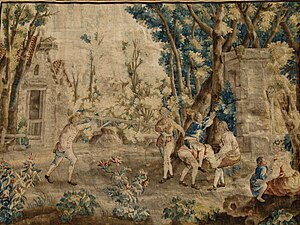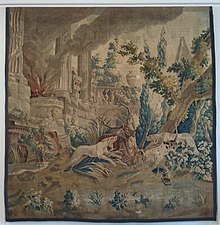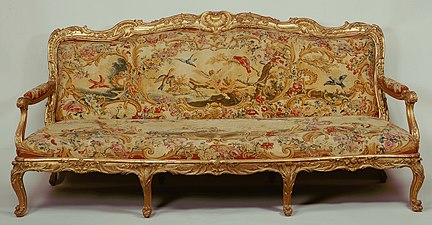Jean-Baptiste Oudry

Jean-Baptiste Oudry (French pronunciation:
Biography

Jean-Baptiste Oudry was born in Paris, the son of Jacques Oudry, a painter and art dealer, and his wife Nicole Papillon,[1] relative of the engraver Jean-Baptiste-Michel Papillon.
His father was a director of the Académie de Saint-Luc art school, which Oudry joined. At first, Oudry concentrated on portraiture, and he became a pupil and perhaps a collaborator of Nicolas de Largillière from 1707 to 1712. He graduated at only 22 years of age, on 21 May 1708, at the same time as his two older brothers. The next year, he married Marie–Marguerite Froissé,[2] the daughter of a miroitier (a mirror-maker) to whom he gave lessons in painting.
Oudry became an assistant professor at Académie de Saint-Luc in 1714, and professor on 1 July 1717. He was inducted as a member of the prestigious Académie royale de peinture et de sculpture in 1719, and was engaged as a professor there in 1743. After producing mainly portraits, Oudry started to produce still life paintings of fruits or animals, as well as paintings of religious subjects, such as the Nativity, Saint Giles, and the Adoration of the Magi.
In the 1720s Oudry was commissioned by Noël-Antoine de Mérou, director of the Royal Beauvais Tapestry Manufactory to create the designs for what has come to be one of the most iconic series of tapestries of the period. The series was called
Through his friend, Jean-Baptiste Massé, a portrait-painter and miniaturist, Oudry was introduced to the Marquis de Beringhen, hereditary master of the royal stables,

M. Hultz, an adviser to the Académie de Peinture, commissioned Oudry to produce a buffet, or still-life combining silver plates and ewers, fruit and game; the work was exhibited in the
Hultz recommended Oudry to Louis Fagon (1680–1744), an
Oudry used a camera obscura in an attempt to speed up the process of producing landscapes, but abandoned it when he saw that the perspective and the effects of light and shade did not appear correct.
Although Oudry produced excellent scenes of animals and of hunting, he also painted portraits, histories, landscapes, fruits and flowers; he imitated
. He was often sent examples of rare birds to draw.
An important patron was
He turned down offers to work for the
Oudry lost some of his responsibilities when Fagon was replaced by de Trudaine. He suffered two strokes in quick succession. The second left him paralysed and he died shortly thereafter in Beauvais (in present-day Oise). He was buried in the Church of Saint-Thomas in Beauvais. His epitaph on the stone was lost when the church was demolished in 1795, but was later found and placed in the Church of Saint-Étienne.
Two exhibitions curated by Hal N. Opperman, first at the Grand Palais, Paris, October 1982 – January 1983, and then in a travelling exhibition in the United States, 1983, encouraged a reassessment of this purely French portraitist and genre painter.
Gallery
Oil paintings
-
Adoration of the Magi (1717), 290 x 260 cm., Église Saint-Georges
-
Still Life with a Spaniel Chasing Ducks "Water" (1719), 141 x 114 cm., Nationalmuseum
-
Still Life with a Rifle, Hare and Bird "Fire" (1720), 144 x 116 cm., Nationalmuseum
-
Still Life of Fruits and Vegetables "Earth" (1721), 145 x 113 cm., Nationalmuseum
-
Allegory of Europe (1722), 161.9 × 151.8 cm., Museum of Fine Arts, Houston
-
Dog Pointing a Partridge (1725), 129 x 162 cm. Hermitage Museum
-
Still Life with Dead Game and Peaches in a Landscape, (1727), 80 x 100.3 cm., Birmingham Museum of Art
-
Louis XV hunting deer in the Saint-Germain forest, (1730), Musée des Augustins, Toulouse
-
Hyena in the Fight with two Dogs (1739), 130 x 190 cm., Ludwigslust Palace
-
The Wolf and the Lamb. from La Fontaine Fables (no date), 104.1 x 125.7 cm., private collection
-
Still Life with Dead Game and a Silver Tureen on a Turkish Carpet (1738), 120 x 171 cm., Nationalmuseum
-
Dachshound Pehr with Game and Rifle (1740), 135 x 109 cm., Nationalmuseum
-
A Hare and a Leg of Lamb (1742), 98.2 x 73.5 cm., Cleveland Museum of Art
-
Swan Attacked by a Dog, (1745), 177.8 x 208.3 cm., North Carolina Museum of Art
-
Cassowary (1745), 161.9 x 127.4 cm., Staatliches Museum Schwerin
-
Still-life with Pheasant (1753), 97 x 64 cm., Louvre
-
The White Duck (1753), 95.3 x 63.5 cm., Houghton Hall [stolen 1990]
-
Still-life with Hare, Partridge and Snipe (ca. 1755), 82.2 x 66 cm., Worcester Art Museum
Textile designs
-
Les Amusements Champêtres: Le cheval fondu tapestry, from the Barlatier de Mas Collection
-
Gobelin "Aktaion" in the "Altes Rathaus" (Old Town Hall) of Bonn, Germany (1750)
-
Settee (sofa) (ca 1754 –56), carved and gilded beech; wool and silk tapestry, 111.8 x 235 x 81.3 cm., Metropolitan Museum of Art
-
The Lion in Love, Aubusson tapestry (ca. 1775–1780), after J-B. Oudry, Musée Nissim de Camondo, Paris.
References
- ^ Bryan,1886-9
- ^ Often incorrectly stated to be Froissié.
- ^ Jean-Louis Beringhen had been premier écuyer to Henri IV, and the post had descended in the family.
- ^ Sold in his posthumous sale, Paris, 2 July 1770.
- ISBN 978-1-904832-77-5.
- ^ His library was sold at auction in 1744 after his death. "Catalogue des livres de feu M. Fagon, Conseiller d'Etat ordinaire, et au Conseil royal, intendant des finances. Dont la vente se fera en détail au plus offrant dernier enchérisseur Mercredi 5 Août 1744. & jours suivans, depuis deux heures de relevée jusqu'au soir en son Hôtel, ruë neuve des Petits-Champs". elec.enc.sorbonne.fr. Retrieved October 11, 2011.
- ^ H.N. Opperman, "The Genesis of the 'Chasses Royales'" The Burlington Magazine 112 No. 805 (April 1970:217-22).
- ^ "José de Rozas y Meléndez de la Cueva, 1st Count of Castelblanco - The Collection - Museo Nacional del Prado". www.museodelprado.es. Retrieved June 8, 2020.
- ^ Frank, in Morton 2007, p. 32.
- ^ Bailey, in Morton 2007, pp. 16–17.
- ^ Frank, in Morton 2007, p. 37.
Further reading
- Morton, Mary, ed. (2007). Oudry's Painted Menagerie: Portraits of Exotic Animals in Eighteenth-Century Europe (collected papers). Los Angeles, CA: J. Paul Getty Museum. OCLC 608484145 – via Google Books.
- Opperman, Hal N.; OCLC 983993520.
- Opperman, Hal N. (1983). Jean-Baptiste Oudry, 1686–1755 (exhibition catalogue). Fort Worth, TX: Kimbell Art Museum. OCLC 1194440663 – via the Internet Archive.
External links
![]() Media related to Paintings by Jean-Baptiste Oudry at Wikimedia Commons
Media related to Paintings by Jean-Baptiste Oudry at Wikimedia Commons
- Biography from the Getty Museum
- Exhibition and blog at the Getty Museum
- Biography from the National Museum of Wildlife Art
- Jean-Baptiste Oudry at WikiGallery.org
- Jean-Baptiste Oudry's Cat Paintings



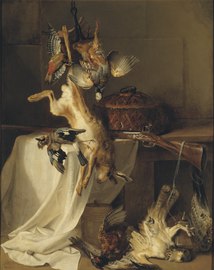

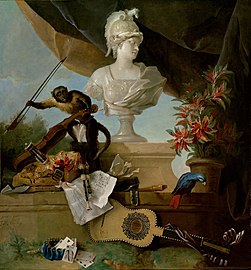










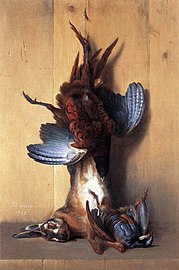
![The White Duck (1753), 95.3 x 63.5 cm., Houghton Hall [stolen 1990]](http://upload.wikimedia.org/wikipedia/commons/thumb/8/86/Cholmondeley_Oudry_White_Duck.jpg/178px-Cholmondeley_Oudry_White_Duck.jpg)

